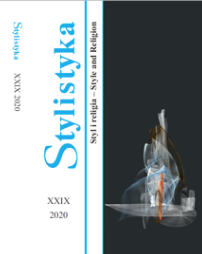Sakralność i patos jako cechy poezji Oświecenia (na przykładzie tłumaczeń psalmów Michaiła Łomonosowa i Franciszka Karpińskiego)
Sacredness and hieratism as features of religious poetry in the Enlightenment (the example of paraphrasing the psalms of Mikhail Lomonosov and Franciszek Karpiński)
Author(s): Joanna GorzelanaSubject(s): Applied Linguistics
Published by: Uniwersytet Opolski
Keywords: style; psalms; sacredness; pathos; archaism
Summary/Abstract: The article compares two Enlightenment translations of psalms made by Lomonosov (into Russian) and Karpiński (into Polish). Their authors used their own sense of a translation method, which allowed them to identify the determinants of style characteristics specific to each translator-poet. The sacredness and hieratism characteristic of the psalm genre were realized by the use of various stylistic means. When identifying the determinants of sacredness, a reference was made to semantic fields, presenting lexis from the sphere of the sacred and profane (e.g. such terms as Absolute and man). Analyzing the determinants of hieratism, the focus was placed on stylistic clues and vocabulary. Translations based on one source show differences, e.g. in the number of terms referring to the Absolute and in the use of archaic forms. The differences result, among others, from the poetry programs of each translator. The author of this study also reminds that during the Enlightenment, in both Poland and Russia, religious poetry developed, and the religious work of Lomonosov, who was an outstanding scientist, proves that there is no contradiction between being devoted to the development of science and faith in God.
Journal: Stylistyka
- Issue Year: 2020
- Issue No: XXIX
- Page Range: 271-292
- Page Count: 22
- Language: Polish

